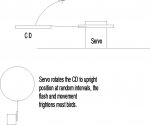Starlings and Indian Myna Birds
Hey Greenie Bob,
Over here on the east coast of Australia we have a possibly bigger problem with an Introduced species, the Indian Myna. These things are a big time pest as they compete with native species especially grass parrrots and lorrikeets, toss them out of their nests, and yep, collect on TV aerials, satellite dishes and ridges soiling the roof, and nest in the eaves. These things are often called 'Noisy Mynas' another problem.
We also have starling problems, but not as much, the Mynas are too numerous.
The most common myna eradication strategy is trapping. Traps used for catching Mynas are also successsful in a "by catch" of Starlings. So if you don't have mynas where you are (sounds like not) then the traps shown will catch the starlings I guess.
http://www.indianmynaeradication.com/index.html
plans for a home made trap for mynas and starlings here:
http://www.indianmynaaction.org.au/
One of the things about mynas is they call out to each other and hunt in packs, i guess from the previous posts starlings do too.
In the mynamagic trap in the URL, the first bird is caught after landing on a mechanical trigger platform. Then when it is trapped it calls out to other birds to assist, and they end up going into the trap through one way funnels. The mechanical trigger is weight of bird dependent, so not 100% perfect. I thought of using a picaxe controlled optical sensor such as Infra red to switch a solenoid which would release the flap.
The way of disposing mynas is by putting the traps in a plastic bag and gassing them with CO2. A waste of good gas in my opinion, and it is something you have to buy.
I thought electrocution might be a humane strategy. A bird sitting on a carefully designed perch fitted with bird leg spaced electrodes could be zapped when a picaxe fitted with optical sensors detected birds happily perched on them for a few seconds. The picaxe can generate a frequency of signal which can then be boosted with transistors and an automotive coil ( not that i could design that).There would be several perches, and the picaxe with sensors would make sure not all the birds were zapped, so there would be birds to call more birds for help. Voltage and current would be appropriate to a creature of that size, copying that from an electronic mouse or rat trap, to make sure it was humanely despatched.
Also another thing i thought of, what about the bird version of an electric fence? If you can somehow string a wire with insulators acrross the top of your ridge, it would be very fine and basically invisible from the street. The picaxe could control capacitor discharges through eg an automotive coil, at appropriate frequency, eg every few seconds. Also give you fault detection, i.e short to ground. Once again, voltage and current would need to be appropriate for discouraging birds, and not discouraging sheep and cattle, or your gutters will be full of dead birds. Could even be solar powered.
I would love to get rid of those mynas - so let us know if picaxe helps.


